A Legacy of Innovation
Researchers are pioneers, journeying into unknown territories, and occasionally discovering a whole new world. Cincinnati Children’s has a rich history of encouraging the intellectual curiosity, innovative spirit and persistent drive that fuels breakthrough discoveries. Here, just a sampling of what has brought us to where we are today.
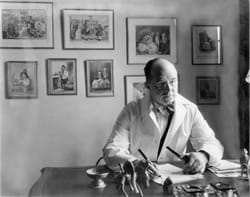 |
Albert Graeme Mitchell, MD-The B.K. Rachford Professor and Chair of Pediatrics of the University of Cincinnati College of Medicine, Mitchell was a visionary who understood the importance of research. |
In 1924, one small research laboratory was available for the Department of Pediatrics, and no one was using it. It didn’t stay that way for long.
1924 was the year Albert Graeme Mitchell, MD, arrived as the B.K. Rachford Professor and chair of Pediatrics of the University of Cincinnati College of Medicine. A man with big ideas, he quickly found an equally visionary partner — businessman and philanthropist William Cooper Procter, president of the Board of Trustees of The Children’s Hospital (now Cincinnati Children’s).
Together they laid the groundwork for the institution Cincinnati Children’s is today.
By the end of 1926, they affiliated Cincinnati Children’s with the College of Medicine as the Department of Pediatrics, opened a new hospital building that increased capacity from 90 to 200 beds, and recruited students into a newly accredited pediatric residency program.
Mitchell was ready for the next step: research.
He argued that “unless effort is made to study and investigate problems in a manner which will add in a constructive way to existing knowledge, we have all of us failed to function to the fullest extent.”
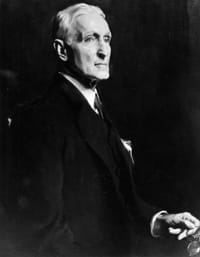 |
William Cooper Procter - A businessman and philanthropist, Procter helped lay the groundwork for the institution Cincinnati Children’s is today. |
Convinced, Procter made a breathtaking gift of $2.5 million to build and endow The Children’s Hospital Clinic and Research Foundation. When it opened in 1931, Cincinnati Children’s became the nation’s first pediatric hospital with a building dedicated to research.
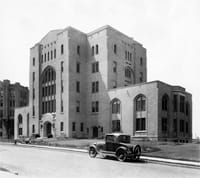 |
| 1931 Cincinnati Children's first research building |
Early Innovators
Mitchell’s first hire was George Guest, MD, who became a co-founder of the Society for Pediatric Research and its president in 1942.
Josef Warkany, MD, arrived from Vienna on January 1, 1932, for a one-year research fellowship. He spent his entire and highly productive career at Cincinnati Children’s.
Warkany gained fame when he showed that mercury in teething powders and ointments caused acrodynia, a painful childhood disease. His work led to mercury being removed from these products. He went on to do pioneering research on nutritional and environmental factors that cause birth defects. In 1971 he completed the influential textbook, Congenital Malformations.
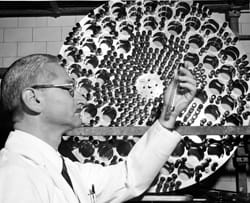 |
Albert Sabin, MD -The Sabin vaccine’s effectiveness and ease of administration made it the vaccine of choice in WHO’s campaign to eradicate polio. |
In 1939, the Research Foundation recruited another promising young scientist: Albert Sabin, MD.
Sabin spent 30 years at Cincinnati Children’s. His research on polio proved that the virus enters the body through the digestive tract. He found polio resistant antibodies in some children, suggesting they had been infected by a weakened strain that produced immunity. Based on these observations, he developed the world’s first attenuated live-virus vaccine.
In 1957, the World Health Organization (WHO) chose Sabin’s vaccine for worldwide testing. The first U.S. test was in Cincinnati on April 24, 1960. The Sabin vaccine’s effectiveness and ease of administration made it the vaccine of choice in WHO’s campaign to eradicate polio.
The War Years
During WWII, Sabin worked on vaccines against Japanese B encephalitis, sandfly fever and dengue fever. Merlin Cooper, MD, helped develop a vaccine for dysentery. Samuel Rapoport, MD, and Paul Hoxworth, MD, developed new methods for preserving blood, which saved lives on the battlefield.
After the war, A. Ashley Weech, MD, who succeeded Mitchell as Pediatric chair, said, “The science of war has left a legacy to the science of peace.”
Sensors and Surgery
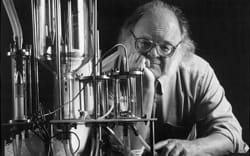 |
Leland Clark, PhD - In the early ’50s, pediatric cardiologist Samuel Kaplan, MD, and surgeon James Helmsworth, MD, worked with Clark to perfect the bubble defoam oxygenator heart-lung machine. |
Leland Clark, PhD, and inventor, joined the Research Foundation in 1968, but his collaboration with Cincinnati Children’s started years earlier.
He began developing his bubble defoam oxygenator heart-lung machine in the 1940s while at Antioch College. In 1951, he contacted the heart care team at Cincinnati Children’s. Pediatric cardiologist Samuel Kaplan, MD, and surgeon James Helmsworth, MD, worked with Clark to perfect the machine and perform one of the earliest open heart surgeries reported in the Journal of the American Medical Association (October 4, 1952).
Clark also developed the first sensor to measure glucose in blood and the Clark oxygen electrode, which is used worldwide in medical and industrial applications.
Discovery Continues
In 1988, neonatologist Jeffrey Whitsett, MD, announced breakthrough research on surfactant. His team identified and cloned two proteins essential to human surfactant. The discovery made it possible to produce synthetic human surfactant for treating premature infants with respiratory distress syndrome. Today surfactant replacement saves thousands of lives every year.
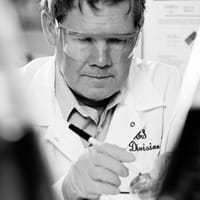 |
Richard Ward, PhD - Ward worked with David Bernstein, MD, to develop an attenuated live-virus vaccine for rotavirus, now marketed as Rotarix. |
It was during the 1980s that Richard Ward, PhD, and David Bernstein, MD, began work on an attenuated live-virus vaccine for rotavirus, now marketed as Rotarix. First licensed in Mexico in 2004, the vaccine is used in over 100 countries. In 2009, WHO recommended that rotavirus vaccine be included in all national immunization programs.
Graeme Mitchell and William Procter would marvel at what their vision has become. Today Cincinnati Children’s ranks second in NIH funding for pediatric research. Earlier this year, we broke ground for a new research tower that will make us the nation’s largest pediatric research facility.
The researchers who make their discoveries there will stand on the shoulders of giants. Their innovations and achievements will be both proud legacy and inspiration for future generations.



